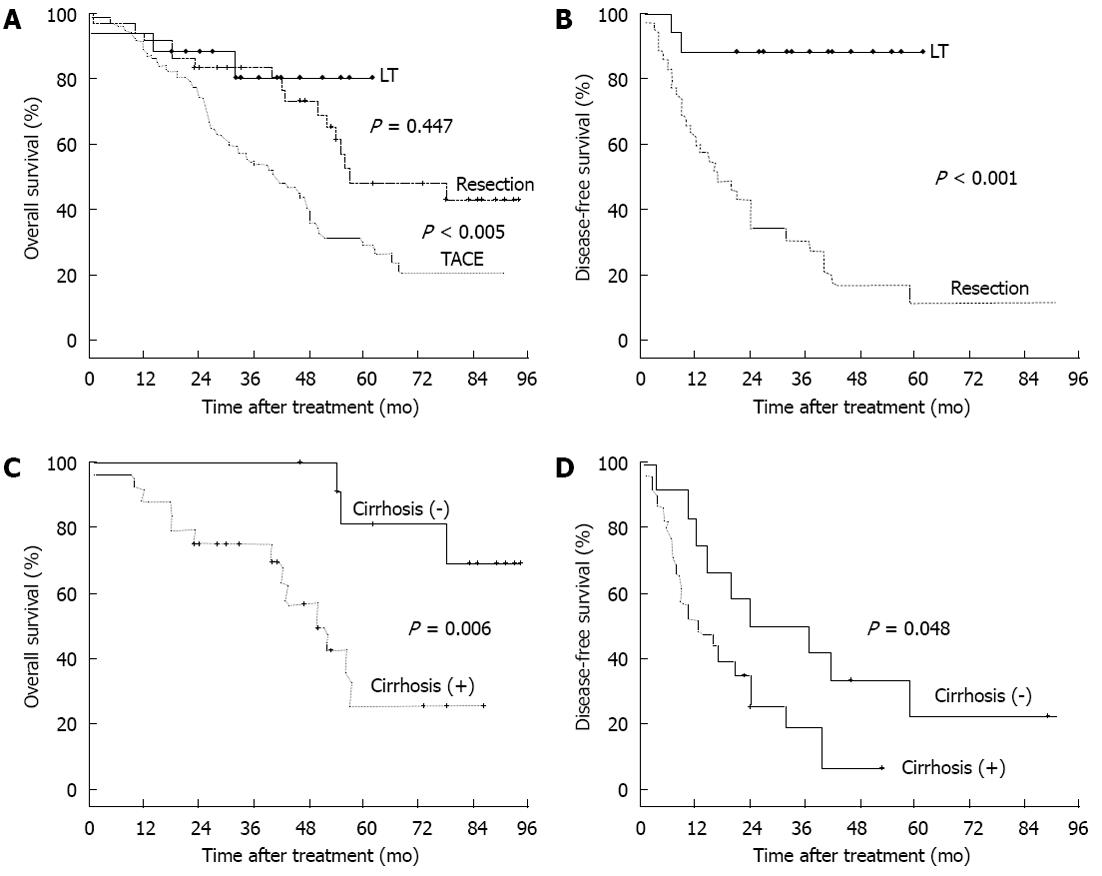Copyright
©2013 Baishideng Publishing Group Co.
World J Gastroenterol. Jan 21, 2013; 19(3): 366-374
Published online Jan 21, 2013. doi: 10.3748/wjg.v19.i3.366
Published online Jan 21, 2013. doi: 10.3748/wjg.v19.i3.366
Figure 1 The overall and disease-free survival curves according to treatment modality and presence of liver cirrhosis in surgical resection patients.
A: The 1-, 3- and 5-year overall survival (OS) rates were 94.1%, 80.2% and 80.2%, respectively, in the liver transplantation (LT) group; 91.7%, 83.3% and 48.1%, respectively, in the resection group; and 88.7%, 55.6% and 28.9%, respectively, in the transarterial chemoembolization (TACE) group. The OS rate was significantly higher in the surgical resection group than in the TACE group (P < 0.005). LT showed the best OS rate (better than the surgical resection group, but not statistically significant, P = 0.447); B: The 1-, 3- and 5-year disease-free survival rates were 88.2%, 88.2% and 88.2% in the LT group and 60%, 30.3% and 11.2% in the resection group, respectively. The disease-free survival rates were also significantly higher in the transplantation group than in the surgical resection group (P < 0.001); C: The 1-, 3- and 5-year OS rates were 100%, 100% and 80.8% in patients without cirrhosis (-) and 87.5%, 75% and 25.5% in patients with cirrhosis (+), respectively (P = 0.006); D: The 1-, 3- and 5-year disease-free survival rates were 75.0%, 50.0% and 22.2% in patients without cirrhosis (-) and 52.3%, 18.7% and 0% in patients with cirrhosis (+), respectively (P = 0.048).
Figure 2 Overall survival curves of surgical resection and transarterial chemoembolization in patients with liver cirrhosis.
Among patients with cirrhosis, the overall survival (OS) rates were not different between the surgical resection group and the transarterial chemoembolization (TACE) group (25.5% vs 24.7% 5-year OS rate, P = 0.225).
- Citation: Choi SH, Choi GH, Kim SU, Park JY, Joo DJ, Ju MK, Kim MS, Choi JS, Han KH, Kim SI. Role of surgical resection for multiple hepatocellular carcinomas. World J Gastroenterol 2013; 19(3): 366-374
- URL: https://www.wjgnet.com/1007-9327/full/v19/i3/366.htm
- DOI: https://dx.doi.org/10.3748/wjg.v19.i3.366










